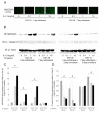IL-13 induces a bronchial epithelial phenotype that is profibrotic
- PMID: 18348727
- PMCID: PMC2292179
- DOI: 10.1186/1465-9921-9-27
IL-13 induces a bronchial epithelial phenotype that is profibrotic
Abstract
Background: Inflammatory cytokines (e.g. IL-13) and mechanical perturbations (e.g. scrape injury) to the epithelium release profibrotic factors such as TGF-beta2, which may, in turn, stimulate subepithelial fibrosis in asthma. We hypothesized that prolonged IL-13 exposure creates a plastic epithelial phenotype that is profibrotic through continuous secretion of soluble mediators at levels that stimulate subepithelial fibrosis.
Methods: Normal human bronchial epithelial cells (NHBE) were treated with IL-13 (0, 0.1, 1, or 10 ng/ml) for 14 days (day 7 to day 21 following seeding) at an air-liquid interface during differentiation, and then withdrawn for 1 or 7 days. Pre-treated and untreated NHBE were co-cultured for 3 days with normal human lung fibroblasts (NHLF) embedded in rat-tail collagen gels during days 22-25 or days 28-31.
Results: IL-13 induced increasing levels of MUC5AC protein, and TGF-beta2, while decreasing beta-Tubulin IV at day 22 and 28 in the NHBE. TGF-beta2, soluble collagen in the media, salt soluble collagen in the matrix, and second harmonic generation (SHG) signal from fibrillar collagen in the matrix were elevated in the IL-13 pre-treated NHBE co-cultures at day 25, but not at day 31. A TGF-beta2 neutralizing antibody reversed the increase in collagen content and SHG signal.
Conclusion: Prolonged IL-13 exposure followed by withdrawal creates an epithelial phenotype, which continuously secretes TGF-beta2 at levels that increase collagen secretion and alters the bulk optical properties of an underlying fibroblast-embedded collagen matrix. Extended withdrawal of IL-13 from the epithelium followed by co-culture does not stimulate fibrosis, indicating plasticity of the cultured airway epithelium and an ability to return to a baseline. Hence, IL-13 may contribute to subepithelial fibrosis in asthma by stimulating biologically significant TGF-beta2 secretion from the airway epithelium.
Figures




Similar articles
-
Interleukin-4- and interleukin-13-enhanced transforming growth factor-beta2 production in cultured human bronchial epithelial cells is attenuated by interferon-gamma.Am J Respir Cell Mol Biol. 2002 Apr;26(4):484-90. doi: 10.1165/ajrcmb.26.4.4784. Am J Respir Cell Mol Biol. 2002. PMID: 11919085
-
Epithelial-derived TGF-beta2 modulates basal and wound-healing subepithelial matrix homeostasis.Am J Physiol Lung Cell Mol Physiol. 2006 Dec;291(6):L1277-85. doi: 10.1152/ajplung.00057.2006. Epub 2006 Aug 4. Am J Physiol Lung Cell Mol Physiol. 2006. PMID: 16891397
-
Differentiation-dependent responsiveness of bronchial epithelial cells to IL-4/13 stimulation.Am J Physiol Lung Cell Mol Physiol. 2004 Jul;287(1):L119-26. doi: 10.1152/ajplung.00365.2003. Epub 2004 Mar 12. Am J Physiol Lung Cell Mol Physiol. 2004. PMID: 15020299
-
TGF-β₂ decreases baseline and IL-13-stimulated mucin production by primary human bronchial epithelial cells.Exp Lung Res. 2013 Feb;39(1):39-47. doi: 10.3109/01902148.2012.748854. Epub 2012 Dec 18. Exp Lung Res. 2013. PMID: 23249391
-
The contribution of interleukin (IL)-4 and IL-13 to the epithelial-mesenchymal trophic unit in asthma.Am J Respir Cell Mol Biol. 2001 Sep;25(3):385-91. doi: 10.1165/ajrcmb.25.3.4437. Am J Respir Cell Mol Biol. 2001. PMID: 11588018
Cited by
-
12/15-lipoxygenase expressed in non-epithelial cells causes airway epithelial injury in asthma.Sci Rep. 2013;3:1540. doi: 10.1038/srep01540. Sci Rep. 2013. PMID: 23528921 Free PMC article.
-
The Epithelial-Immune Crosstalk in Pulmonary Fibrosis.Front Immunol. 2021 May 19;12:631235. doi: 10.3389/fimmu.2021.631235. eCollection 2021. Front Immunol. 2021. PMID: 34093523 Free PMC article. Review.
-
Update on the role of alternatively activated macrophages in asthma.J Asthma Allergy. 2016 Jun 3;9:101-7. doi: 10.2147/JAA.S104508. eCollection 2016. J Asthma Allergy. 2016. PMID: 27350756 Free PMC article. Review.
-
Development of Adaptive Immunity and Its Role in Lung Remodeling.Adv Exp Med Biol. 2023;1426:287-351. doi: 10.1007/978-3-031-32259-4_14. Adv Exp Med Biol. 2023. PMID: 37464127
-
The Biology of Eosinophils and Their Role in Asthma.Front Med (Lausanne). 2017 Jun 30;4:93. doi: 10.3389/fmed.2017.00093. eCollection 2017. Front Med (Lausanne). 2017. PMID: 28713812 Free PMC article. Review.
References
-
- Busse W, Elias J, Sheppard D, Banks-Schlegel S. Airway remodeling and repair. Am J Respir Crit Care Med. 1999;160(3):1035–1042. - PubMed

